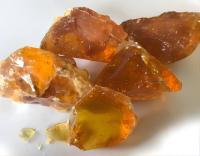| Chemical Properties | solid with a slight odour of turpentine |
| Uses | Rosin is a yellow resin in the production of varnishes, printing inks, paper, soldering fluxes, greases, cutting fluids, glue tackifiers, adhesives, surface coatings, polish, insulations, waxes, cosmetics (mascara, rouge, eye shadow), topical medicaments, shoes, violin bow rosin, day, athletic grip aid, pine-oil cleansers; component in dental impression materials and periodontal packings. |
| Uses | Rosin can be used as a glazing agent in medicines and chewing gum. In industry, rosin is a flux used in soldering. A mixture of pitch and rosin is used to make a surface against which glass is polished when making optical components such as lenses. |
| Definition | A brittle yellow or brown resin that remains after the distillation of turpentine. It is used as a flux in soldering and in making paints and varnishes. Powdered rosin gives a ‘grip’ to violin bows and boxers’ shoes. |
| Definition | rosin: A hard natural resin obtainedfrom pine tree oil and the wastesfrom processing wood pulp. It maybe colourless, yellow, brown, or black. It is used as a flotation agent,solder flux, sizing compound, and inlacquers and plasticizers. It is alsoused to provide ‘grip’ to violinists’bows (when it may be calledcolophony) and dancers’ and boxers’shoes.
 |
| Production Methods | Rosin, also called colophony or Greek pitch (Latin: pix graeca), is a solid form of resin obtained from pines and some other plants, mostly conifers, produced by heating fresh liquid resin to vaporize the volatile liquid terpene components.
|
| Composition | Rosin is a complex mixture that mostly contains resin acids and a little amount of neutral fraction. Rosin mostly contains abietic type (abietic, levopimaric, pallustric, neoabietic, dehydroabietic and tetra abietic acids) and pimaric type (pimaric and isopimaric acids), besides neutral components. |
| General Description | Gum rosin is an exudate gum, which is extracted from pine trees. |
| Health effects | The fumes released during soldering have been cited as a causative agent of occupational asthma. The symptoms also include desquamation of bronchial epithelium. |